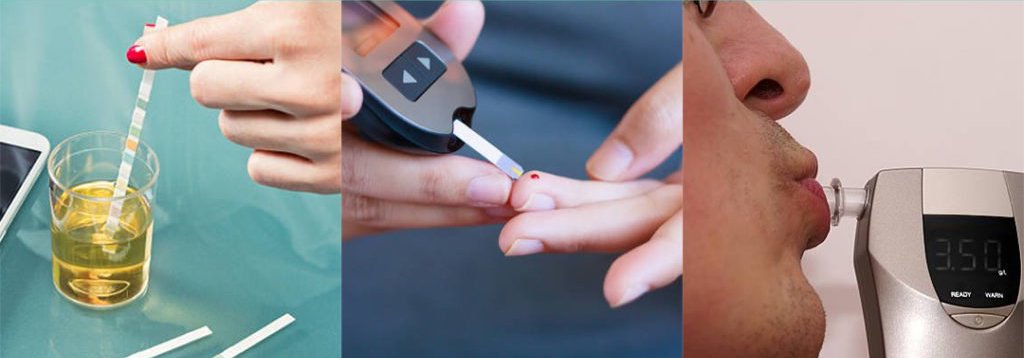There are 3 ways to test for ketones in the body:
- Urine ketones
- Breath ketones (Acetone)
- Blood ketones (Beta-hydroxybutryate or BHB)
Urine Ketones
In the early stages of ketosis, or during before you are keto-adapted, you can test for ketones using urine test strips. These are relatively low-cost and may be tested anytime you want to know if your body is producing ketones.
Urine ketones are ketones which the body has decided it cannot use and is discarding via the urine. This test method is able to find out whether your body is producing ketones, but isn’t able to test if your body is using ketones for energy.

The test strips are extremely sensitive to moisture and just leaving the bottle in a damp warm toilet may spoil all the strips! Keep the bottle in a cool dry place at all times, and minimise the time the bottle is open by taking your test strip out, and closing the cap immediately. Testing is relatively simple:
- You will need a watch or stopwatch for this test as it is time-sensitive.
- Test only when you feel the urge to urinate. It may be easier to use a clean collection bottle as you have to count the timing once the strip has been wet. If using a collection bottle, ensure that the bottle has been washed before the test as not to contaminate the sample
- Do not collect the initial urine as it may be more concentrated, and might skew the test results. Collect the sample after some pee has been passed.
- If not using a collection bottle, allow the urine to flow over the test zone on the test strip after some pee has been passed. If using a collection bottle, dip the test strip in the urine and pull it out. The test zone should start changing if ketones are detected.
- Start the stopwatch or watch the time on your watch. At 40 seconds (or whatever time the instructions that come with the test strips states), immediately compare the colour of the test zone with the colour chart on the bottle to get your ketone level.
After you are keto-adapted, the body will burn ketones more efficiently for energy, and this test may show a very low level of ketones, or even no ketones in your urine, even if your body is producing ketones.
Breath Ketones
When your body is burning ketones for energy, it is usually manifested by acetone in the breath. Your family and friends may tell you that you have really bad breath, or you may detect a fruity smell on your breath.

You can purchase a relatively low-cost breathalyser from AliExpress to test for your breath ketones. Testing is quite simple:
- Turn on the breathalyser, it will take 10 seconds to warm up
- Breathe normally while watching the timer count down, and take a deeper breath just before the breathalyser is ready. Some people recommend a rebreather method, where you breathe in and out of a small plastic bag, and take a deeper breath just before the breathalyser is ready.
- When the breathalyser beeps to indicate it’s ready, put the mouthpiece in your mouth, form a good seal and blow out slowly into the device. It might beep once or twice to indicate it has enough breath sample.
- When the breathalyser beeps to indicate it has enough breath sample, it will show the results.
In the initial state of ketosis, your breath may not show any results as your body has not started burning ketones for energy. You may have a very low reading in the early stages of keto-adaptation, and the readings will be significant when your body is keto-adapted, and actively burning ketones for energy.
The breathalyser is designed with a low-cost semiconductor which cannot tell the difference between ethylene (drinking alcohols) and acetone, hence this is a low-cost test method which is reusable as the only consumable is the batteries to power the device.
You may get readings as low as 0.0 – 0.2 g/L in the early stages, but as your body is keto-adapted, they should rise to above 0.5g/L.
Blood Ketones
This is the most accurate method to test for ketones in your body. If you have ever done a simple blood glucose test, it is relatively painless as it only involves a finger prick and uses only a drop of blood.
As this test has evolved, blood ketones alone may no longer be an accurate test for metabolic health, and a combination of blood glucose and blood ketone tests provides a better gauge of your ketosis level. This reading is called the Glucose-Ketone Index.
You have to purchase a blood glucose and ketone meter, which is available at your local pharmacy.
The meter most used for diabetic care in the USA is the Abbott Precision Xtra. The test strips for this meter cost US$28.24 for 30 strips.

In Singapore, the Abbott FreeStyle Optium Neo is available in local pharmacies. It comes bundled with glucose test strips, but not ketone test strips, which are sold separately. The ketone test strips for this meter are more costly as it is primarily a diabetic glucose test device.
If you are savvy with online-shopping, you may be able to buy meters which come with cheaper ketone test strips.
I’m using the Fora 6 Connect glucose-ketone meter. This meter supports bluetooth sync to iOS and Android devices. The meter (bundle) comes with 50 glucose test strips, 50 ketone test strips, a lancing device and 100pc of disposable lancets in a convenient carrying case. Additional ketone test strips cost US$53.99 for every 50 strips.
If you are looking for an alternative device, there’s also the Keto-Mojo from Amazon. The meter comes with 10 ketone test strips, a lancet device and 10pc of disposable lancets in a carrying case. Additional ketone test strips cost US$49.50 for every 50 strips.
